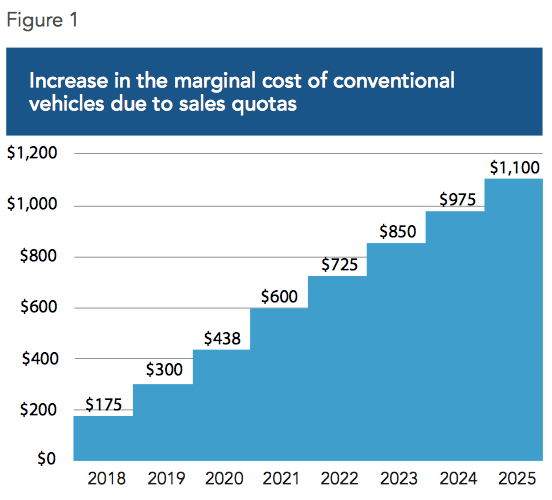Resistance Grows: Car Dealers Push Back Against Electric Vehicle Quotas

Table of Contents
Financial Strain and Infrastructure Challenges
Meeting electric vehicle quotas presents a significant financial burden for many dealerships. The high upfront investment required to adapt to the EV market creates substantial pressure on already tight profit margins.
High upfront investment costs for EV infrastructure.
Dealerships need to make significant investments to handle EVs effectively. This includes installing new charging stations, a costly undertaking that varies based on the number of fast chargers, slow chargers, and the overall electrical grid capacity upgrades needed. Furthermore, they need to train their mechanics on the specifics of EV repair and maintenance, a process requiring specialized tools and equipment that are not necessarily compatible with gasoline vehicle servicing.
- High cost of charging stations: The initial investment in charging infrastructure can run into tens of thousands of dollars, depending on the size and type of installation.
- Lack of skilled EV technicians: Finding and training technicians with the expertise to service EVs is a challenge, adding to labor costs.
- Need for specialized tools and equipment: Repairing EVs requires specialized diagnostic tools and equipment not typically found in traditional service bays.
Slower EV Sales Compared to Traditional Vehicles.
While EV sales are growing, they still lag behind traditional gasoline-powered vehicles in many markets. This disparity impacts dealerships' ability to meet their electric vehicle quotas.
- Higher purchase prices of EVs: The higher initial cost of EVs compared to gasoline cars remains a significant barrier for many consumers.
- Range anxiety concerns: Concerns about the driving range of EVs and the availability of charging stations continue to deter potential buyers.
- Limited charging infrastructure in certain areas: The uneven distribution of charging stations, particularly in rural areas, creates range anxiety and limits EV adoption.
Impact on Profit Margins.
The combined effect of higher upfront investment costs and slower EV sales significantly impacts a dealership's profit margins.
- Reduced profit per vehicle sold: The lower sales volume of EVs, coupled with potentially lower profit margins on each sale, contributes to reduced overall profitability.
- Increased operational costs: The costs associated with EV infrastructure, training, and specialized equipment add to operational expenses.
- Potential financial losses: In some cases, dealerships might experience financial losses due to the substantial investment in EV infrastructure and lower EV sales volume.
Supply Chain Disruptions and Inventory Management
Beyond financial challenges, dealerships are grappling with significant supply chain disruptions impacting their ability to obtain and manage EV inventory.
Difficulties in obtaining sufficient EV inventory.
The global supply chain continues to face disruptions affecting the availability of EVs. This is especially true given the crucial role of semiconductor chips and batteries in the EV manufacturing process.
- Long waiting lists for EV models: Many popular EV models have lengthy waiting lists, making it difficult for dealerships to meet demand and quotas.
- Inconsistent supply from manufacturers: Manufacturers are struggling to meet the growing demand for EVs, leading to inconsistent supply for dealerships.
- Increased shipping costs: Global shipping disruptions have increased transportation costs for EVs, impacting dealership profitability.
Balancing EV and Traditional Vehicle Inventory.
Dealerships must carefully manage their inventory, balancing the need to stock both EVs and traditional vehicles.
- Inventory management complexities: Managing two distinct vehicle types with different logistical requirements presents significant inventory management challenges.
- Risk of overstocking certain models: The unpredictable nature of EV demand increases the risk of overstocking EVs while simultaneously understocking gasoline-powered vehicles.
- Need for efficient inventory tracking systems: Dealerships require sophisticated inventory tracking systems to manage the complexities of their EV and gasoline vehicle inventories.
Consumer Resistance and Education
Despite government incentives, consumer resistance and a lack of awareness about EVs remain significant hurdles.
Addressing Consumer Concerns and Misconceptions.
Many potential buyers harbor misconceptions about EVs, including concerns about range, charging times, and overall cost of ownership.
- Educating consumers about EV benefits: Dealerships need to actively educate consumers about the environmental and economic benefits of EVs.
- Addressing range anxiety: Addressing range anxiety through education on charging infrastructure and real-world driving ranges is crucial.
- Highlighting government incentives and subsidies: Dealerships should emphasize the availability of government incentives and subsidies to reduce the upfront cost of EVs.
Marketing and Sales Strategies for EVs.
Dealerships must adapt their marketing and sales strategies to promote EVs effectively.
- Targeted advertising campaigns: Targeted advertising campaigns focusing on specific demographics and addressing common consumer concerns are essential.
- Showcasing EV features and benefits: Highlighting the unique features and benefits of EVs, such as lower running costs and reduced emissions, is critical.
- Training sales staff on EV technology: Sales staff require thorough training on EV technology to effectively address customer questions and concerns.
Conclusion
The implementation of electric vehicle quotas presents significant challenges for car dealerships. The high upfront costs of EV infrastructure, slower EV sales compared to traditional vehicles, supply chain disruptions, and consumer resistance all contribute to the difficulties dealerships are facing. These challenges highlight the complex interplay between government mandates to accelerate electric vehicle adoption and the practical realities faced by the automotive retail sector. Understanding the complexities surrounding electric vehicle quotas is crucial for navigating the future of the automotive industry. Learn more about the challenges and opportunities in this evolving landscape, and explore strategies for successfully managing the transition to a more sustainable automotive future – including exploring alternatives to strict EV quota mandates.

Featured Posts
-
 Swedens Tanks Finlands Troops A Pan Nordic Defense Force
Apr 22, 2025
Swedens Tanks Finlands Troops A Pan Nordic Defense Force
Apr 22, 2025 -
 Anti Trump Protests Hear Their Stories
Apr 22, 2025
Anti Trump Protests Hear Their Stories
Apr 22, 2025 -
 Ray Epps V Fox News A Deep Dive Into The January 6th Defamation Case
Apr 22, 2025
Ray Epps V Fox News A Deep Dive Into The January 6th Defamation Case
Apr 22, 2025 -
 Secret Service Investigation Concludes Cocaine Found At White House
Apr 22, 2025
Secret Service Investigation Concludes Cocaine Found At White House
Apr 22, 2025 -
 U S China Relations Breakdown And The Looming Cold War
Apr 22, 2025
U S China Relations Breakdown And The Looming Cold War
Apr 22, 2025
